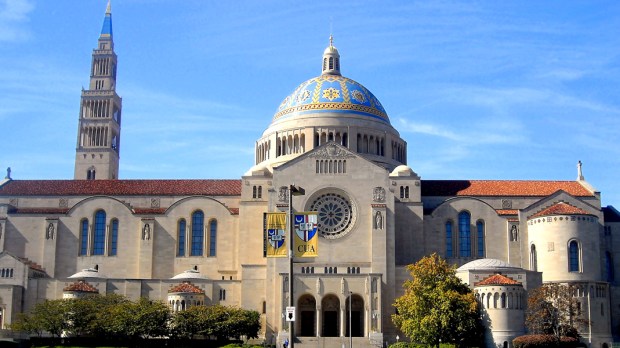On Good Friday, April 14, the National Shrine of the Immaculate Conception in Washington, D.C, will have a special exposition of various relics associated with the Passion of Jesus Christ.
According to the National Shrine, the rare collection will include numerous items from the Holy Land, including:
Particle of the Table of the Lord’s Supper Particle of Stone from the Garden of Gethsemane Particle of the Scourging Pillar Particle of the Purple Garment Particle of the Rope that bound the hands of Jesus Particle of the Crown of Thorns Particle of Stone from Golgotha (Calvary) Particle of the Seamless White Tunic Shavings of the Spike or Nails Particle of the Sponge filled with vinegar (sour wine) and the Reed. Particle of the Lance Particles of Burial Cloths and Bindings Particle of Stone from the Holy Sepulchre Particle of the True Cross
The event will last from 7:00 a.m. to 7:00 p.m. and is free and open to the public.
The veneration of relics is an ancient tradition of the Church that has roots in Sacred Scripture.
For example, we read in the Gospel of Mark how a woman believed that if she only touched Jesus’ cloak, she would be healed.
She had heard the reports about Jesus, and came up behind him in the crowd and touched his garment. For she said, “If I touch even his garments, I shall be made well.” And immediately the hemorrhage ceased; and she felt in her body that she was healed of her disease. (Mark 5.27-29)
Additionally, in the Book of Acts we see similar healings with items associated with the apostles.
And God did extraordinary miracles by the hands of Paul, so that handkerchiefs or aprons were carried away from his body to the sick, and diseases left them and the evil spirits came out of them. (Acts 19.11-12)
Most relics associated with the Passion of Jesus Christ date back to a miraculous discovery by St Helena.
Tradition relates (confirmed by the contemporary sources of St John Chrysostom, St Ambrose, Rufinus, and Gelasius, to name a few) that St Helena was inspired by God to travel to the Holy Land in search of the true cross of Jesus Christ.
It was said that after Jesus’ death, those responsible for accusing Jesus hid the cross in a ditch, covering it with stones so that the early Christians would not be able to venerate it. In the years that followed, a pagan shrine was also built upon the same site in honor of the goddess Venus, most likely constructed during the reign of the Emperor Hadrian.
Read more:
Could a ship be built from all the relics of the True Cross?
Through a series of events that involved the healing of an individual, St Helena discovered many relics in the Holy Land, which in turn where distributed or brought back to Rome. The relics were fragmented and encased in reliquaries so that larger numbers of the faithful could venerate them and so be brought closer to Jesus.
Similar to relics of the saints, these holy items are not meant to be worshiped, but venerated as tools to lead a soul to God and the sacraments of the Church.
As the Catechism explains,
“Besides sacramental liturgy and sacramentals, catechesis must take into account the forms of piety and popular devotions among the faithful. The religious sense of the Christian people has always found expression in various forms of piety surrounding the Church’s sacramental life, such as the veneration of relics, visits to sanctuaries, pilgrimages, processions, the stations of the cross, religious dances, the rosary, medals, etc. These expressions of piety extend the liturgical life of the Church, but do not replace it. They ‘should be so drawn up that they harmonize with the liturgical seasons, accord with the sacred liturgy, are in some way derived from it and lead the people to it, since in fact the liturgy by its very nature is far superior to any of them.’”

